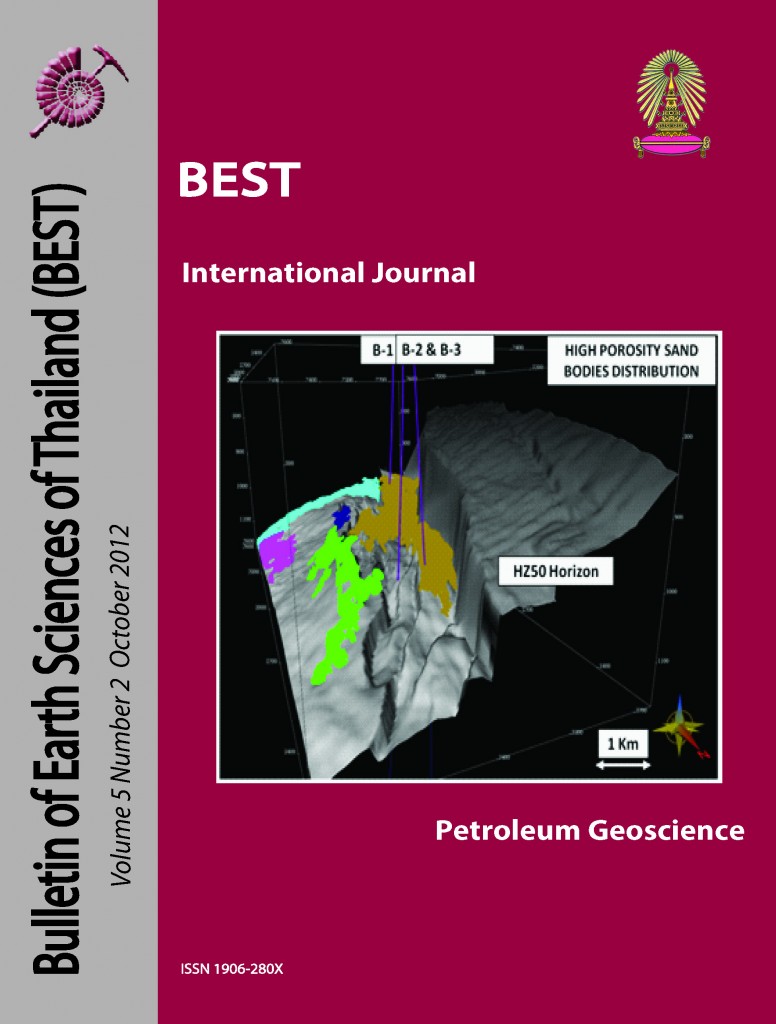STRUCTURAL DEVELOPMENT OF THRUSTS, FOLDS AND FRACTURES IN QUARRY EXPOSURES OF PERMIAN LIMESTONES, PAK CHONG, NAKHON RATCHIMA PROVINCE, CENTRAL THAILAND: IMPLICATION FOR FRACTURED RESERVOIR DEVELOPMENT IN NE THAILAND
Main Article Content
Abstract
Detailed field study and laboratory analysis show Permian carbonates in Pak Chong, Nakhon Ratchasima Province are deformed into folds and thrusts by N - S compressional stress during the burial stage (Indosinian Orogeny). This created a series of calcite-filled E - W fractures, and related features, via transpressional stress. After that, tectonic reactivation during the Cenozoic created a set of N - S fractures. These N - S fractures are widespread at the reservoir scale and tend to be partially to completely open fractures.
This structural evolution, as mapped in the field, is supported by stable isotope measurements (carbon and oxygen) of vein-filling calcites, which show a clear temperature and time-relation separation along the same burial trend into: Group I: cooler and shallower; defined by pervasive fluid crossflow in the matrix, driving ongoing calcite cementation and isotope re-equilibration in the matrix and in early fractures, and, Group II: hotter and likely deeper; indicates fault- and fracture-focused calcite precipitation. By this burial stage the matrix is largely impermeable due to pervasive calcite cementation and stylotitisation, which had shut down matrix fluid flow, so that fluid flow was confined to tectonically activated fractures and faults.
This temperature-related bipartite isotope trend refines the earlier isotope burial trends established by Ampaiwan (2011) and Thanudamrong (2011), who studied structural and diagenetic evolution in the same folded and thrusted formation (Khao Khad Formation), but at different locations in Central Thailand. In combination, this study and the previous two, have now established a reliable stable isotope-derived burial trend in Central Thailand (made up of more than 250 isotope pairs). It can be used as a yardstick to test and compare other isotopic analyses conducted in Permian carbonates of Thailand. Much of the earlier work in Thailand has interpreted stable isotope values in various spar cements as indicators of meteoric or mixing zone diagenesis.
The model of structural evolution, fracture development and sequential calcite precipitation, as defined in this study, can now be used to refine our understanding of fluid flow evolution in fractured reservoirs hosted in Permian carbonates in gas and oilfields; such as Sin Phu Horm and Nam Pong gas fields in NE Thailand and Nang Nuan field in offshore Thailand.
Article Details

This work is licensed under a Creative Commons Attribution-NonCommercial-NoDerivatives 4.0 International License.
Copyright © 2008 Department of Geology, Faculty of Science, Chulalongkorn University. Parts of an article can be photocopied or reproduced without prior written permission from the author(s), but due acknowledgments should be stated or cited accordingly.
References
Allegre, C. J., 2008, Isotope Geology, Cambridge University Press, 512 p.
Ampaiwan, P., 2011, Structural development of thrusts, folds and fractures in Permian Limestone quarries, Saraburi Province: implication in NE Thailand: Master thesis Chulalongkorn University.
Dunham, R. J.,1962, Classification of carbonate rocks according to depositional texture. In Ham, W. E.. Classification of carbonate rocks: American Association of Petroleum Geologists Memoir. 1. p. 108-121
Malila, K., C. K. Morley, and B. Chaisiboon, 2008, Tectonics of the Western Khorat Plateau: Significance for Hydrocarbon Exploration, The 2nd Petroleum Forum: Blooming Era of Northeastern Thailand, Department of Mineral Fuels, Bangkok, Thailand, p. 66-71
Nelson, C. S., and A. M. Smith, 1996, Stable oxygen and carbon isotope compositional fields for skeletal and diagenetic components in New Zealand Cenozoic nontropical carbonate sediments and limestones: a synthesis and review: New Zealand Journal of Geology and Geophysics, v. 39, p. 93-107
Ridd F.M. amd Morley C. K. (2011). The Khao Yai Fault on the southern margin of the Khorat Plateau, and the pattern of faulting in Southeast Thailand. Proceedings of the Geologists’ Association (122): p 143-156.
Thanudamrong, S., 2011, Structural style and fracture characteristics of thrusted and folded Permian Carbonated in the Siam City Cement Company quarry, Tab Kwang, Saraburi; Analogs for fractured carbonates: Master thesis Chulalongkorn University.
Tingay, M, C. K. Morley., Richard R. Hillis , Jeremy Meyer (2010). Present-day stressorientation in Thailand’s basins. Journal of Structural Geology 32: 235-248.


